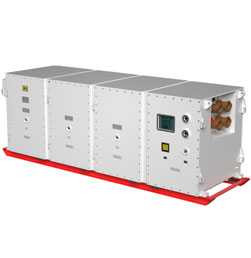What is a Frequency Converter
A motor requency converter, also known as a variable frequency drive (VFD), is an electronic device that is used to control the speed of an electric motor by varying the frequency of the power supplied to it.
The motor frequency converter works by converting the incoming AC power into a stable DC voltage, and then converting the DC voltage back into an AC voltage of the desired frequency using an inverter. The inverter switches on and off rapidly to create a series of voltage pulses that approximate a sine wave of the desired frequency.
By varying the frequency of the voltage pulses, the speed of the motor can be controlled. This allows for precise speed control of the motor, which can lead to energy savings, improved process control, and reduced wear and tear on the motor and associated equipment. CCS Motors offer high voltage frequency converter and solid state frequency converter.
Frequency Converter Application
Voltage and Frequency Converter for Cooling Tower: The use of a voltage and frequency converter on a cooling tower fan is the most useful means to control leaving water temperature on critical process water applications. Motor Frequency Converter can help save energy and reduce the noise of cooling tower in non-peak periods and benefit the life of the motor frequency converter components with fewer starts, smoother starts, and built-in motor diagnostics.
Voltage and Frequency Converter in Mining Applications: Voltage and frequency converter are now finding wide use in mining applications.
Voltage and Frequency Converter for Water Pumps: The installation of voltage and motor frequency converter on water pumps can be an effective energy saving measurement. Voltage and frequency converter can be installed on all water pumps, including those associated with HVAC systems.
Benefits of Using Motor Frequency Converters
1. Speed regulation and saving energy, which can save energy by lowering the motor speed when it is not necessary to run at full speed.
2. Soft start can be used to prolong the service life of the voltage and frequency converter.
3. The motor control system is simplified.
4. Reduce mechanical wear and loss.
Frequency Converter Working Principle
Static frequency converter working principle: The electric frequency converter mainly adopts AC-DC-AC mode, which first converts the power frequency AC power supply into DC power supply through the rectifier, and then converts the DC power supply into AC power supply with controllable frequency and voltage to supply the motor. The voltage and frequency converter converts a basic fixed-frequency, fixed voltage sine-wave power (line power) to a variable-frequency, variable-voltage output used to control speed of induction motors.
Frequency Converter VS VFD
1.Power Supply: VFD is composed of AC-DC- AC (modulation wave) circuits. Voltage and frequency change proportionally at the same time and can not be adjusted separately, which does not meet the requirements of the AC power supply. In principle, it can not be used for power supply, and VFD is generally used for speed regulation of three phase asynchronous motor. The whole circuit of motor frequency converter consists of AC-DC-AC-Filter Circuit, so the output voltage and current waveform are pure sinusoidal, which is very close to the ideal AC power supply. Voltage and frequency converter can output the power grid voltage and frequency of any country in the world.
2.Load Test: VFD(vfd rated motors) can't use in load tests because of high vibration and electromagnetic noise, large temperature rise, and the instruments can't work normally. So the voltage to frequency converter that can provide a pure sine wave output becomes indispensable power equipment in the laboratory.
3. Converter: A VFD is not a typical converter though it has conversions inside it. A voltage frequency converter would typically convert a DC signal to an AC signal.

 English
English 한국어
한국어 français
français Deutsch
Deutsch Español
Español italiano
italiano русский
русский português
português العربية
العربية Ελλάδα
Ελλάδα






